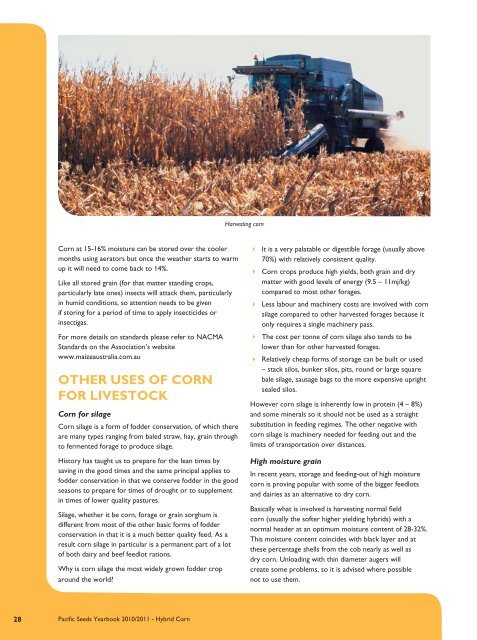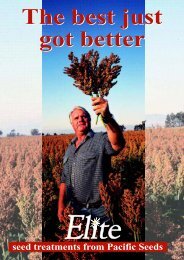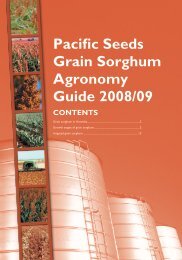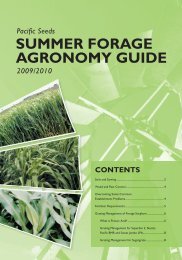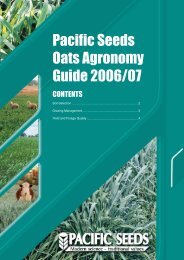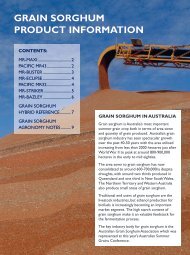You also want an ePaper? Increase the reach of your titles
YUMPU automatically turns print PDFs into web optimized ePapers that Google loves.
Harvesting <strong>corn</strong><br />
Corn at 15-16% moisture can be stored over the cooler<br />
months using aerators but once the weather starts to warm<br />
up it will need to <strong>com</strong>e back to 14%.<br />
Like all stored grain (for that matter standing crops,<br />
particularly late ones) insects will attack them, particularly<br />
in humid conditions, so attention needs to be given<br />
if storing for a period of time to apply insecticides or<br />
insectigas.<br />
For more details on standards please refer to NACMA<br />
Standards on the Association’s website<br />
www.maizeaustralia.<strong>com</strong>.au<br />
Other uses of <strong>corn</strong><br />
for livestock<br />
Corn for silage<br />
Corn silage is a form of fodder conservation, of which there<br />
are many types ranging from baled straw, hay, grain through<br />
to fermented forage to produce silage.<br />
History has taught us to prepare for the lean times by<br />
saving in the good times and the same principal applies to<br />
fodder conservation in that we conserve fodder in the good<br />
seasons to prepare for times of drought or to supplement<br />
in times of lower quality pastures.<br />
Silage, whether it be <strong>corn</strong>, forage or grain sorghum is<br />
different from most of the other basic forms of fodder<br />
conservation in that it is a much better quality <strong>feed</strong>. As a<br />
result <strong>corn</strong> silage in particular is a permanent part of a lot<br />
of both dairy and beef <strong>feed</strong>lot rations.<br />
Why is <strong>corn</strong> silage the most widely grown fodder crop<br />
around the world<br />
4 It is a very palatable or digestible forage (usually above<br />
70%) with relatively consistent quality.<br />
4 Corn crops produce high yields, both grain and dry<br />
matter with good levels of energy (9.5 – 11mj/kg)<br />
<strong>com</strong>pared to most other forages.<br />
4 Less labour and machinery costs are involved with <strong>corn</strong><br />
silage <strong>com</strong>pared to other harvested forages because it<br />
only requires a single machinery pass.<br />
4 The cost per tonne of <strong>corn</strong> silage also tends to be<br />
lower than for other harvested forages.<br />
4 Relatively cheap forms of storage can be built or used<br />
– stack silos, bunker silos, pits, round or large square<br />
bale silage, sausage bags to the more expensive upright<br />
sealed silos.<br />
However <strong>corn</strong> silage is inherently low in protein (4 – 8%)<br />
and some minerals so it should not be used as a straight<br />
substitution in <strong>feed</strong>ing regimes. The other negative with<br />
<strong>corn</strong> silage is machinery needed for <strong>feed</strong>ing out and the<br />
limits of transportation over distances.<br />
High moisture grain<br />
In recent years, storage and <strong>feed</strong>ing-out of high moisture<br />
<strong>corn</strong> is proving popular with some of the bigger <strong>feed</strong>lots<br />
and dairies as an alternative to dry <strong>corn</strong>.<br />
Basically what is involved is harvesting normal field<br />
<strong>corn</strong> (usually the softer higher yielding hybrids) with a<br />
normal header at an optimum moisture content of 28-32%.<br />
This moisture content coincides with black layer and at<br />
these percentage shells from the cob nearly as well as<br />
dry <strong>corn</strong>. Unloading with thin diameter augers will<br />
create some problems, so it is advised where possible<br />
not to use them.<br />
28<br />
Pacific Seeds Yearbook 2010/2011 - Hybrid Corn


